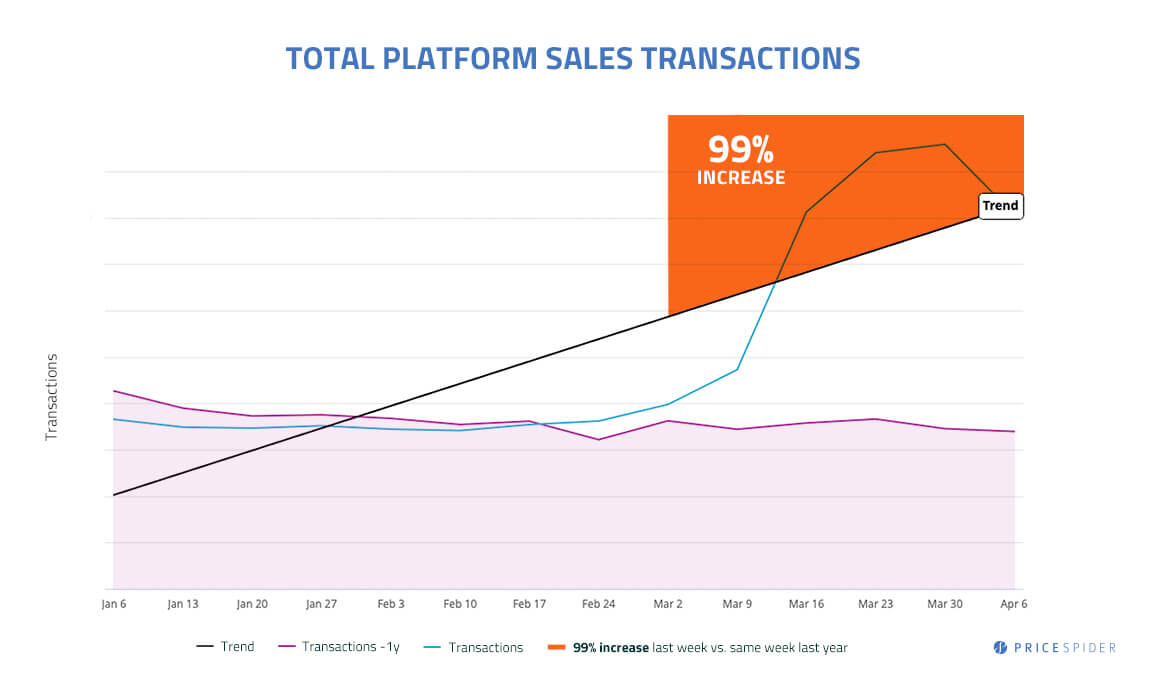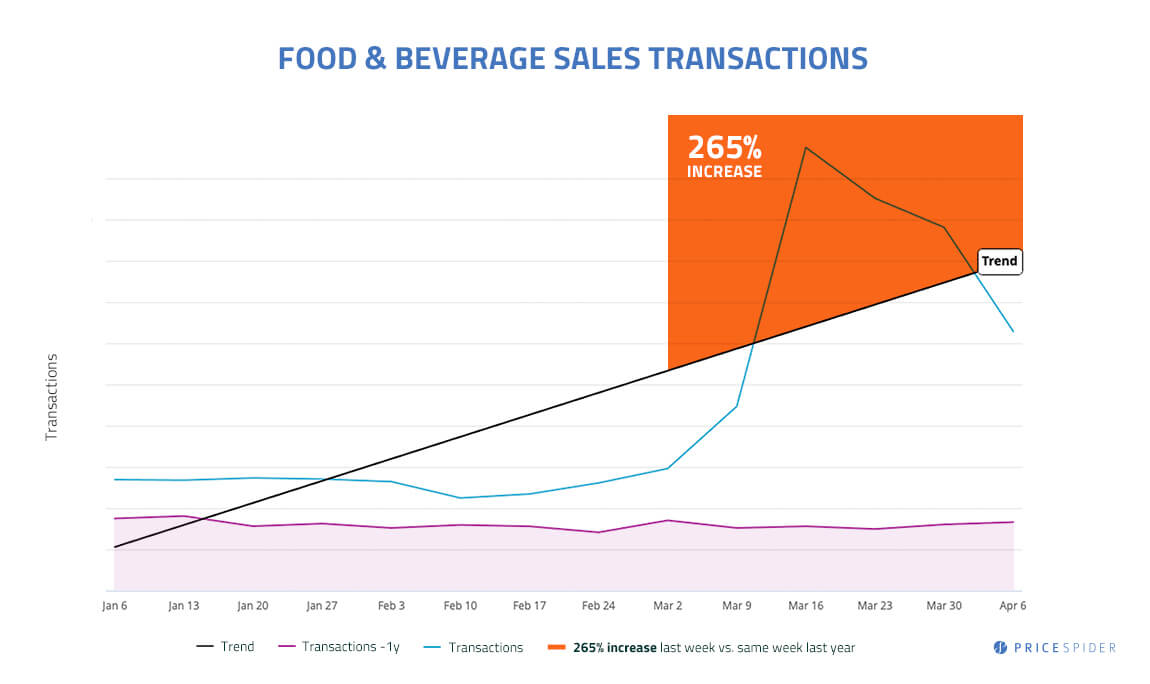A lot of brands are seeing a massive increase in website traffic and ecommerce sales in the wake of COVID-19. In fact, comparing sales from March 3, 2020 to April 12, 2020 to last year’s sales, our total platform saw an increase of 99 percent in transactions (including categories that were trending down). And while transactions are starting to level off this week, the Food and Beverage category alone, saw an increase in sales of 264 percent during this time compared to 2019 as states issued stay-at-home orders and public health recommendations evolved.


Some brands have been thriving in ecommerce all along. Others are rapidly learning how to adapt to a world where consumers are avoiding brick-and-mortar stores. Wherever your brand falls on the spectrum, you’re likely wondering: how do we make the most of this moment, but even more importantly, how do I prepare for the future?
Brands that do the best job serving consumers through this crisis and utilizing the strengths of ecommerce are going to see market penetration and brand loyalty that lasts well beyond the pandemic.
Here’s what you should do if your ecommerce traffic and/or sales are through the roof right now.
Optimize your product pages
Your product pages obviously play a vital role in the shopping experience. But they aren’t just a stepping stone on the way to checkout. They’re where consumers explore your product category, learn from previous customers, ask questions, and research whether or not your product will meet their needs.
The perfect product page serves consumers on several stages on the customer journey. If you want to maximize sales and grow your brand, you need to turn your product pages—both on your own site and retailers’ sites—into a one-stop shop for everything potential customers want to know.
You’ll also want to take advantage of each retailer search engine. Make sure your titles and descriptions prioritize the right keywords, features, and specs so that when consumers look for your product category, they find your products first.
If you’re having a spike in ecommerce traffic or sales, more people than ever are seeing your product pages. It’s the perfect time to make sure these pages are providing an ideal experience.
Keep in mind: If your product pages proactively answer questions—including questions about stock availability, delays, or anything unusual related to the increase—this can also reduce the strain on your customer service team.
Identify content gaps on your website
When it comes to educating potential customers, your product pages do a lot of the heavy lifting on your website. But there are also a lot of things people search for online before they even know about your product category—such as how to solve a problem, complete a task, or reach a goal—and your product page isn’t really the place to put guides, tutorials, checklists, and other content that helps people at this stage. But if your website provides this kind of content, you can use it to catch the right people’s attention before they even know they need your product. And if you’re the one educating consumers about your product category, you have a big advantage over your competitors.
You can also use website content to serve consumers on the other end of the customer journey. Once someone becomes a customer, your website can be a great place for them to learn how to get the most from your product, receive technical support, or even see personalized recommendations based on order and viewing history. Fleshing out your website with content like this can help you retain more customers, increase brand loyalty, and drive additional transactions.
Highlight your best retail partners
No matter how good your unique value proposition is, some of your customers are going to buy from their preferred retailer to take advantage of perks or the convenience of buying options like BOPIS (buy online, pick-up in store).
Instead of seeing retail partners like Amazon, Target, and Walmart as competitors, the most successful ecommerce brands are leveraging those relationships by highlighting them on their website. If you only sell direct-to-consumer or you hide retail relationships, you’re going to lose sales to inferior products and competitors simply because some consumers wanted to buy from Best Buy.
Using a Where to Buy button, you can increase conversions by allowing your website visitors to choose where and how they want to buy your products. With a click, they can move from researching your product on your website to buying from their preferred retailer.
This functionality is even more important when you’re seeing a surge in sales. You may want to promote sellers that still have your products in stock, whoever provides the best ecommerce experience (which reflects well on your brand), or simply whichever retailer has the highest conversion rate.
Get better visibility into your marketing campaigns
For a lot of ecommerce brands, one of the biggest obstacles to investing in marketing is that they don’t know which promotions and channels are working and which ones aren’t. If you can only track sales that occur on your own website, you’re going to miss all the transactions that happen when someone leaves to buy your product from a retailer.
To measure the impact of your marketing campaigns, there are three main metrics you need to be able to track:
- Impressions
- Reseller redirects
- Sales
That’s why when we created our Where to Buy solution, we didn’t just build a powerful conversion optimization platform—we also developed the necessary data-sharing relationships with retailers. So when you use our tools, you gain valuable insights into where your sales are coming from and how your marketing efforts are actually performing. Additionally, you’ll get access to valuable in-cart data like how much people spent and what they’re buying alongside your products.
When your sales are through the roof, this data will help you understand what’s going on and help you capitalize on it.
Double-down on your highest converting channels
Once you have the data to see which marketing channels and campaigns are producing the best results, it’s time to put more of your marketing budget behind the things that actually generate sales—and cut back on the work that isn’t paying off.
Experiment with new opportunities
There are many strategies you can use to reach your target audience. But without the ability to measure their impact, a lot of brands are cautious about using their energy on new marketing channels and opportunities. When you can track conversions on retailers’ websites, all of a sudden it’s a lot more worthwhile to experiment with things like influencer marketing, retargeted ads, and social media content.
Learn more
If you want to maximize ecommerce sales, investing in a conversion optimization platform is crucial. At PriceSpider, we help businesses increase conversions, protect their brands, and gain valuable insights into their target audience.
Schedule a demo today, and see what PriceSpider can do for you.

